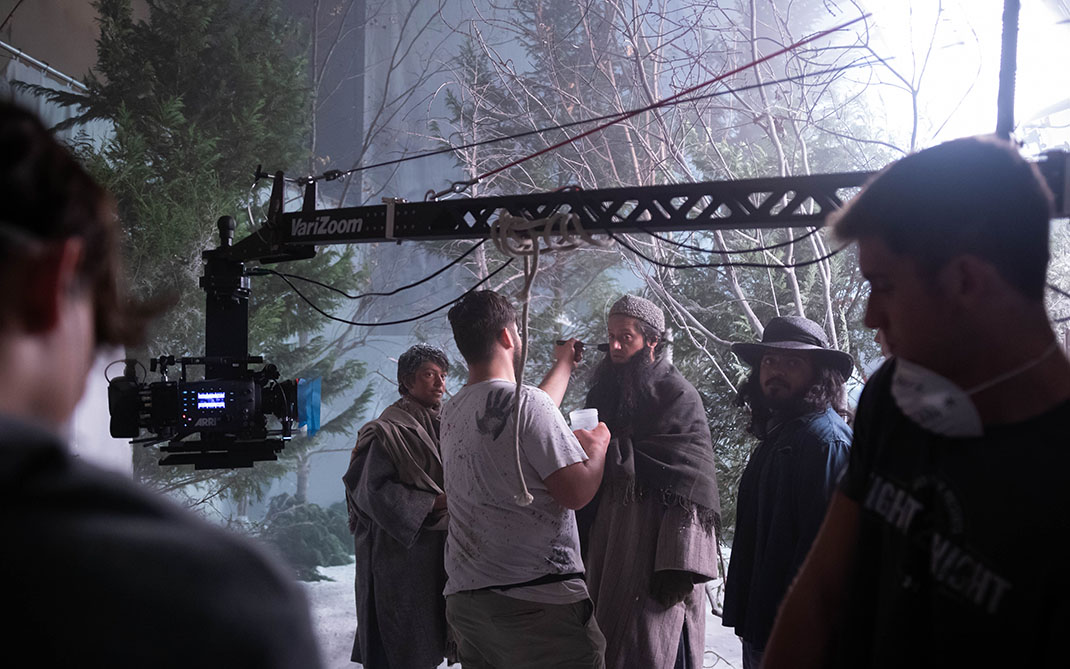Serial entertainment: shifting paradigms for an evolving industry
When UNCSA launched its film school in the fall of 1993, movies were king. Blockbusters like “Jurassic Park” were bringing audiences out to a growing multiplex theatrical market, while an independent cinema boom, driven by the rise of directors like Steven Soderbergh (“sex, lies and videotape”), Quentin Tarantino (“Reservoir Dogs”) and John Singleton (“Boyz N the Hood”), was opening up film to a whole new generation.
Meanwhile, at home, families were clocking most of their television hours in front of sitcoms like “Home Improvement,” “Seinfeld” and “Grace Under Fire.” Though ABC was prepping the launch of “NYPD Blue,” the police drama series that would plant some of the earliest seeds of a new golden age for the small screen, television was still very much seen as a lesser medium. It certainly wasn’t anywhere near today’s realm of
“Peak TV,” to steal a phrase from FX Networks Chairman John Landgraf, and it wasn’t a production paradigm that a new film school was likely to focus on, either.
By the end of the decade, HBO’s mafioso epic “The Sopranos” would change the TV game in a big way, sparking a period of evolution and growth for the medium throughout the 2000s. A rising tide of cable networks, including AMC, FX, Showtime and TNT, packed their offerings with distinctive episodic series that kept viewers coming back for more.
Thanks to the advent of online streaming, the audience for serial entertainment has exploded. Since 2013, when Netflix broke ground with the political drama “House of Cards,” the number of new scripted television series has nearly doubled. In 2021, as the COVID-19 pandemic continued to drive interest from an at-home audience, a record 559 shows debuted on screens across the U.S. and Canada, according to data by Statista.
In a reflection of these industry trends, creating work for the small screen is now an important part of the training at the School of Filmmaking at UNCSA.
“About six years ago, when I first came to UNCSA, it was still very feature-centric,” said Peter Werner, a member of the film school’s graduate screenwriting faculty who brought decades of experience directing series like “Moonlighting,” “Justified” and “Grimm” with him. “Because of my background in television, it was clear to me that this is where the jobs are.”
Since that time, the volume of training for television work has skyrocketed at UNCSA. It’s even become a note in onboarding; one of the things Werner says the school asks of new students, just to get a gauge, is whether their interests lie in feature or series development. At least 50 percent express a preference for being part of a writers room on a series over scripting a studio feature.
“All the students talk about is ‘Euphoria’ or ‘The Witcher’ or ‘Bob’s Burgers,’” Werner said. “They’re not talking about 90 percent of the feature market.”
Following industry trends is one thing, but it’s also important to work toward versatility in how students are generating their material. Lauren Vilchik, assistant dean of graduate studies, notes how the film school’s entrepreneurial focus has begun to include a multipronged approach so that students can be quick-footed and able to pivot — increasingly important in an industry where development executives often wonder about serialized versions of the submissions they’re receiving.
I teach financing and independent filmmaking and raising equity, and the business plans used to be, you would put together a fundraiser for a feature. Now, we put together a fundraiser where you pitch the same story for different modalities. ... It’s about getting students to wrap their minds around that.
Lauren Vilchik
“I teach financing and independent filmmaking and raising equity, and the business plans used to be, you would put together a fundraiser for a feature,” Vilchik said. “Now, we put together a fundraiser where you pitch the same story for different modalities. What’s the VR experience that can act as a marketing tool for the feature? Think of the feature as the pilot. What’s the story, long-form or short-form? Why wouldn’t there be a limited series version of a feature script? It’s about getting students to wrap their minds around that.”
That kind of creative malleability came in very handy for screenwriter Travis Beacham, who wrote the feature fantasy screenplay “A Killing on Carnival Row” during his fourth year at UNCSA, in 2004. When he graduated the following year, he was fortunate enough to sell the project to New Line Cinema. But for the longest time, Beacham’s murder mystery, set in a Victorian-themed city of fantastical creatures and humans, languished as filmmakers like Guillermo del Toro and Robert Zemeckis merely flirted with bringing it to the big screen.
“It just seemed like the sacrificial lamb, this thing that I love dearly that had to die to give me my career,” said Beacham, who went on to write the scripts for “Clash of the Titans” and “Pacific Rim.” “At some point along the way, Thomas Tull, the head of Legendary Pictures, gave me a call and said he was thinking about buying it from New Line and asked if I could see it as a TV show.”
Beacham had indeed been thinking along those lines. He recalls taking an interest in television when he was in film school, as shows like “Lost” and “Deadwood” began to reveal the possibilities of world-building on the small screen. Bolstered by more recent successes like “Game of Thrones,” he dug back into his feature script and expanded it for a season of genre television. It finally debuted as “Carnival Row” on Amazon Prime in 2019, 15 years after Beacham had conceived it.
“I think it helps, as a TV show, just fleshing out the characters and giving them the space to develop and figure out who they are,” Beacham said. “In features, you’re so limited that you never really get to be character-driven. You never get to that level where you can really delve into a character’s psyche.”
The film school’s series focus culminated this year in the graduate program with the first full soup-to-nuts realization of a serial production. Until then, the work had remained mostly on the page. But with “Masterpiece,” a six-episode series about a struggling violin student who finds musical inspiration in committing violent acts, there is a finished product to showcase.

Behind the scenes of “Masterpiece,” a six-episode series made in the School of Filmmaking during the 2021-22 academic year. The series is the result of a first-time collaboration between the undergraduate and graduate filmmaking programs.
“My big vision for the grad program was to be development-focused,” Vilchik said. “Students would prove concepts, and then they would interact with the undergrads, who mostly would crew for grad projects. This is the first time we were able to pull that off.”
After the initial concept was pitched by second-year graduate student Sarah Deitrich, who then became the showrunner, the series was developed by students in the “Writers Room” elective course. Vilchik then reached out to third-year undergraduate producer Rohit Lila Ram, who came on board to shepherd “Masterpiece” through a lightning-fast production.
Lila Ram brought in third-year student director Brady Walker, as well as alumnus Jim Boemio (B.F.A. Filmmaking ’20), to helm the six episodes. He also tapped third-year student cinematographer Summer Sierra, who would find herself dealing with an unexpected but eye-opening situation during the shoot.
“The biggest challenge was that we would be shooting multiple episodes in one day, which meant scene by scene, I’d be switching off which director I was working with,” Sierra said. “The pace of our work was hard to adjust for sometimes. It was a learning curve.”
According to Gilana Lobel, a 2005 graduate of the school’s producing program who has worked as a production coordinator and production manager on series like “Person of Interest” and “Russian Doll,” that kind of deep-end training is perfect, because it reflects real-world television production.
“My first job was on an episodic television show, and I didn’t know that they rotated episodes, that they weren’t filming everything all at once,” Lobel said. “But that was network television back then. Now that you have all of the streamers, you have a lot of shows that are all cross-boarded, filmed like a feature, where you’re filming out locations (shooting everything that takes place there before moving on), and you’re not focused on the full structure of an idea of the episode. You’re filming everything all at once.”
It’s all about instilling a knowledge base and familiarity in students who are heading out into a constantly shifting professional landscape. “It is our job to prepare students not only for the industry of today, but for the future,” said Deborah LaVine, who became dean of the School of Filmmaking in July 2021. “Our goal is to be a space to shift paradigms, not just follow trends. The proliferation of streaming and the advent of so much beautiful work in this area is a wonderful opportunity for our students, and one that exists in synchrony with our training in the process of creating short and feature-length films.”
Kristopher Tapley (B.F.A. Filmmaking ’04) has covered the film and television industry for 17 years, with bylines at Variety, The New York Times and The Times of London. He now works as a writer and a consultant in Los Angeles, where he lives with his loving wife, lively son and lazy cat.
This article appeared in the 2022 issue of Scene.
READ THE COMPLETE ISSUE
July 21, 2022


